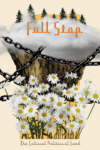The following is the introduction to the latest issue of the Full Stop Reviews Supplement. To read the rest, subscribe at our Patreon page.
In the late nineteenth and early twentieth centuries, fears circulated that circulating libraries might transmit diseases including smallpox, scarlet fever, and influenza through the pages of books. In attempts to disinfect them, library books were baked, steamed, misted with carbolic acid, fumigated with formaldehyde, and burned.
In response to such fears, the author of an 1883 article in Library Journal called“Libraries and Disease”satirically argued that for those afraid of being infected by a disease transmitted by a library book, it would be advisable to “never read a book after it has been read by anyone else.” The author doubts that books serve as vectors of disease, and believes the panic around the matter to have been instigated by opponents of the burgeoning public library movement. Nevertheless, the fact that he sees this solution to infectious books as itself absurd, draws attention to an important fact: reading is social. It was, of course, the aim of the public library movement to initiate the emergence of a new, wider reading public through the transmission of literature. Priscilla Wald writes in Contagious: Cultures, Carriers, and the Outbreak Narrative that“the interactions that make us sick also constitute us as a community. Disease emergence dramatizes the dilemma that inspires the most basic of human narratives: the necessity and danger of human contact.” Where reading is often thought of as primarily a solitary practice, a relationship developed between a reader and their book, in this way these fears of infectious literature highlighted the materiality and sociality of books, indexing the larger infrastructures supporting acts of reading.
This issue of the Full Stop Reviews Supplement is about exploring some of these infrastructures of reading. As the coronavirus pandemic makes present our vast social interconnections mediated by global capitalism, and the failures of the present system to adequately care for the social forms it shapes, this issue’s special feature includes four pieces exploring the ways small press literary culture has been shaped by, and creatively responded to, some of these forces. We begin with an essay by Kaja Marczewska who traces the way in which small press collectives in the 1970s such as the Visual Studies Workshop and the Committee of Small Magazine Editors and Publishers used bookmobiles as a way to appropriate the US’s infrastructure of highways to cultivate a wider audience for alternative literary culture. This is followed by an excerpt from Iris Cushing’s The First Books of David Henderson and Mary Norbert Korte: A Research (Ugly Duckling Presse; 2020). There, she describes the early days of small press publishing in the US as a significant node of 1960s anti-institutional cultural production. She illustrates this through the story of the publication of “beatnik nun” Mary Norbert Korte’s first book Hymn to the Gentle Sun, made possible through an unexpected confrontation between the Catholic Church and the expanding community of the Bay Area poetry scene. Next, in “What would a twenty-first-century Federal Writers Project look like?,” an excerpt from The Deep End: The Literary Scene in the Great Depression and Today (OR Books; 2020), Jason Boog asks, What can we learn from labor organizing of writers during the Great Depression? He looks back to a hunger strike organized in 1936 by members of the American Writers Union in response to massive firings by the Works Progress Administration, and argues that writers today must see themselves as workers if they are to have any chance of transforming an increasingly consolidated publishing industry. Finally, looking at one contemporary example of how alternatives to mainstream literary culture are improvised, rex renée leonowicz interviews the members of Radix Media, a Brooklyn-based, worker-owned, cooperative print shop and publisher that prioritizes innovative, radical writing and artwork. They discuss their origins and how their politics informs their aesthetic values and innovations on the existing infrastructures of the publishing industry.
The remainder of the issue includes some of our favorite reviews of books published by small and university presses. Like the writers highlighted in the special feature, we at Full Stop believe that a vibrant small press literary sphere is an indispensable part of an alternative to mainstream culture, and that this requires the appropriation and creation of new infrastructures for imagining, creating, producing, distributing, and consuming that culture. It also requires spaces for the thoughtful, creative, sustained engagement with this culture. It is for this reason that Full Stop exists. Full Stop’s non-hierarchical, volunteer editorial collective, and our contributors, are motivated by the desire to read, respond to the works of small presses and the marginalized stories, styles, and communities of writers they represent. Read within and become part of this circulation.
Subscribe at our Patreon page to read the rest of the issue.
This post may contain affiliate links.








